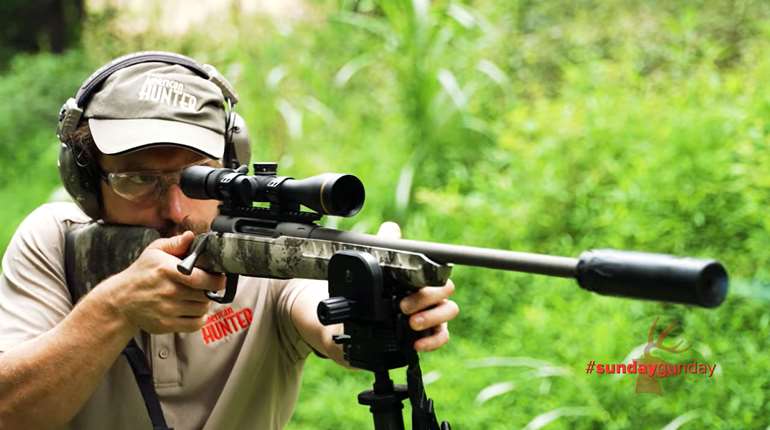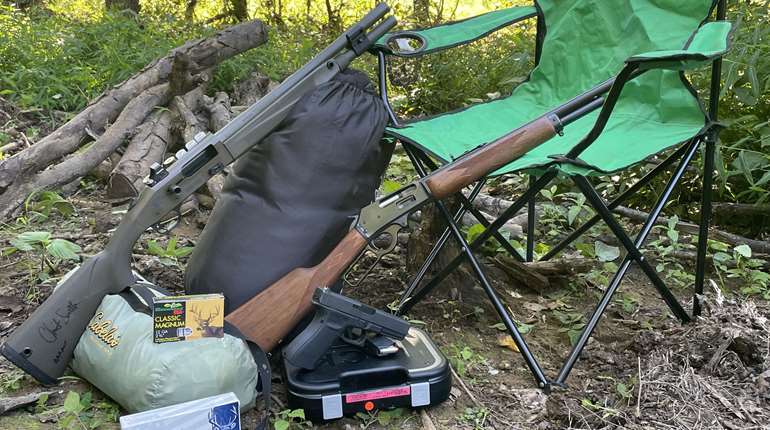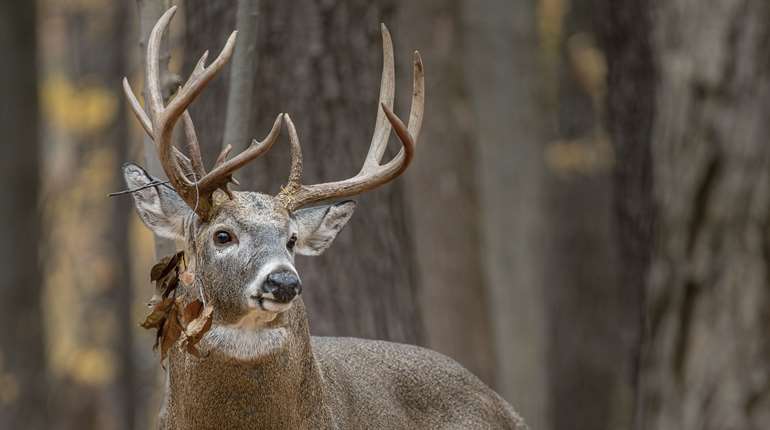In late September, I hiked into Utah’s Uinta Mountains with my .30-30 carbine. Though elk were rutting, big bulls stayed out of my path. On the hunt’s final morning, I beat dawn to a north slope. The dry litter whispered of elk already above me. Under these conditions, I had no chance of catching them.
Then a branch snapped nearby. I crept to an aspen. Movement behind a snowberry grew antlers. I found a shot alley just as the bull saw me. The Hornady FTX felled him 19 steps away.
I figured that Marlin was up for one more elk hunt—this in Montana’s Bob Marshall Wilderness.
Now, The Bob can be stingy with its elk; the first time there, I’d killed the only bull I had seen in a week. Watching John Way’s linebacker shoulders rock to the rhythm of his horse ahead, I wondered this time if the slab-sided carbine under my knee was a good choice. My gun rack at home bristled with potent scoped bolt-rifles. Fourteen miles up the Blackfoot, there’d be no switching.
Pulling saw-bucks and Deckers from the mules under an early moon, the white canvas aglow with Coleman light and horses nickering in the corral, I felt oddly at ease. Generations of hunters had plied this country with carbines just like mine.
Expectations, Tempered
These days, finding elk on public land can test your patience and endurance. Where elk once cut deep trails in meadows they mowed to lawn height, echoes of bugling bulls have faded. You’ll want to make the most of any chance at a branch-antlered bull—if, indeed, you’re licensed to fire. “Spikes only” rules have become common, with mature bulls legal by drawn permit only. In Washington, recent stipulations further restrict hunters to “true spikes”: bulls with no fork, either side. Reduced opportunity sparks grumbling among sportsmen."
“I haven’t hunted elk for six years,” whined one fellow the other day. A few probing questions told me the man needed a reality check. He’d formed his opinion of elk hunting, and his expectations, in a top elk unit during the 1980s, when the animals were plentiful, seasons generous. He’d had more iron in his legs then, too. It was no trick to slip away from the crowds to find huge bulls that seldom saw people.
He was spoiled. I’d seen such symptoms in hunters recalling two-buck limits in Colorado’s deer factories. Three decades before elk numbers peaked, riflemen in the central Rockies were tripping over bucks with rocking-chair racks. The Okanogan hills in Washington and the Snake River breaks cleaving Idaho from Oregon, with the Grey’s drainage in Wyoming and Montana’s Highline, produced huge deer. Surely, these bucks aren’t all gone. Neither are the elk, once plentiful in the tangles of Kelly Creek, the sprawling meadows of the Danaher and the Thoroughfare. These days, though, there’s more competition.
Wolves, whose numbers in Idaho, Montana and Wyoming now far exceed original targets, have established viable packs in the Pacific Northwest. Wherever they occur, they can affect elk herds and elk hunting. In my experience and that of outfitters I’ve queried, wolf predation pushes elk to steep, thick places where killing is more difficult for the canids. Because wolves have learned to listen for elk, bulls have learned to rut with less fanfare. Like rooster pheasants that sprint rather than fly, bull elk survive by keeping a low profile. A similar shift in behavior, by the way, can follow bugling by hunters in heavily pressured elk cover.
Flashlight beams danced in the dark as we saddled up that first cold morning in The Bob. Hooves sucked mud and limbs swiped my face as Darrell and I paralleled the river’s south fork. An hour later we swung stiffly from our horses. Dawn had yet to penetrate a thick ceiling; the sky leaked freezing drizzle.
At noon we nursed a fire in a sticky snow. At dark we rode back into camp. We’d seen nothing.
That night, heavy frost stiffened the grass. Before dawn we tucked into hotcakes, snugged cinches and eased onto icy saddles. In vain we rode farther, hiked higher and probed thicker places. Near dusk, we mounted again to climb a steep face. We tied the lathered geldings below ridgeline.
A reply to Darrel’s pipe quavered faintly from afar. He blew again. The bull bellowed, closer. He was coming! We struggled up through the timber, fire in our lungs, lead in our legs.
Spent, Darrell dropped beside a pine. I managed a few more steps, then bellied down. Elk-yellow winked through the aspens. Antlers snapping limbs, the bull burst into the woods upon us. I fired into his chest. He spun and vanished in second-growth.
I lay still. He’d not fallen. Movement would send him off. But silent minutes later I could stand it no longer and inched to the side. A patch of rib appeared. I triggered my Marlin. The elk boiled from the timber on shaky legs. I fired again and they gave way.
The world is full of people who’ve shot more elk than I, and who’ve had more field time with any given elk round. Still, in 40 years of hunting, I’ve used nearly three dozen cartridges on elk. Most popular now: the .30-06 and .270, the 7mm Remington and .300 Winchester magnums. The .308, too. Whatever your choice, learn to shoot well from hunting positions. Best load? No space for that chat here. You’ll find more than 80 factory loads for the ’06 alone. In .30s, stay with strong bullets of 165 to 180 grains. Get a 4X scope, or a variable no bigger than 40mm up front. Leave the variable at 4X after zeroing at 200 yards. You can kill elk at 300 yards with a high-shoulder hold.
Crowds Noted, Elk Found
You can’t count on elk to charge into your lap, or even peek shyly from close cover. On an Idaho hunt recently, I carried an iron-sighted Winchester 71 in .450 Alaskan. Optimism or hubris? I thought the Frank Church Wilderness would yield at least one bull within reach. It did not. I downed a bull with my partner’s rifle at just over 300 yards. He used the same rifle to kill a raghorn at 390. That’s long shooting, but more common these days. Partly that’s because hunters have rifles, optics and ammo with reach. It’s also because many hunters without gray hair have come to the sport without having used iron sights at all. They expect to shoot long. They don’t try to get close.
Unwittingly, these riflemen make elk more difficult to find. Death that visits meadows sends elk into timber. Bullets raining from popular perches move elk into places that can’t be riddled from on high.
Habits of other hunters should affect your own. Want to waylay elk sifting from shadows at dusk or pick off a bull in that saddle? Good strategies—but on public land, you’re planning what other hunters are thinking, or have tried. Better to go where other hunters don’t, where elk seek asylum.
Conventional wisdom has it that elk lived on the plains until shooting and agriculture shouldered them into the mountains. Makes sense. Elk are big beasts with broad muzzles. They’re designed to graze, unlike deer whose slim noses help them snip young shoots from bushes. Still, elk and deer diets overlap, especially when range is stressed. Whatever their pre-settlement distribution, elk are at home in timber, and they scale mountains with the sure-footedness of sheep. Thick hide and hair insulate them against the cold. They prefer shaded “norths” on high-elevation summer range, where snow-melt keeps grass green after lowland plants have dried up. Alpine meadows and forests offer seclusion.
But come hunting season, pack-trains wind their way into the heart of high elk range. White wall tents pop up in meadows pocked by elk beds. Meanwhile, armies of horseless hunters cruise the logging roads at mountain’s base. Savvy bulls drift into timber at mid-slope.
Mid-slope, you’ll find cruel places: lodgepole patches with deadfalls that trip and impale you, fir thickets that dump snow down your neck, rockslides that turn your legs to rubber. Elk like these environs because hunters don’t. Noisy, difficult cover and footing also warn bedded elk of intruders. While many canyon bottoms qualify as difficult, you’ll seldom find elk living there, because thermal drag during the day, when hunters are afoot, is uphill. Besides poor wind coverage, bottoms offer elk few escape routes. Climbing is hard, slow work and exposes animals to the opposite slope. Elk prefer to loaf a rifle shot off ridgeline—far enough down to hide them from hunters patrolling it but close enough to the top to reach it quickly when threatened from below. High-slope trails get lots of elk traffic.
Once, having prowled likely knobs in the foothills of Oregon’s Wallowa Mountains, I descended through thickets I’d passed on my morning climb. They erupted in elk! Dozens thundered down-slope. I ran ahead, saw only rumps. Then, from the side, antlers winked through trees I’d now twice walked past. I tagged the bull with my .338. Elk that have found a place hunters ignore can hold as tight as whitetails.
The next season, I came off the same ridge on a hot, dry afternoon that didn’t promise much. As the cover opened up, I speeded up. Just off the trail ahead a spot of yellow caught my eye. Too close to stop without alarming the elk, I walked on, swinging wide of the bedded bull without looking at him. The rifle slid from my shoulder into my hands. Spinning and bringing the .270 to bear in one motion, I botched my chance as the elk rocketed away. Once you’re on an elk’s radar, a shot comes hard.
You can cash in on popular spots by hunting them when other hunters don’t. The first elk I killed, more than 40 years ago, strolled into a meadow as I looked the other way, glassing the far edge. Turning, I almost jumped out of my skin. The 6-point was watching me benignly from 60 steps. This public land, closed to vehicles but easy to walk, was swamped by hunters. I’d not found a secret pocket; rather, I had just stayed afield until dark, while my competition was at camp sipping smooth Southern mash.
Another time on that ridge, I found a bull at a seep around noon, when other hunters took lunch. Hot weather had pulled this spike to water. Neither of us expected to see the other. I recovered first.
Threading elk country between highway and timberline, you’re hunting where elk numbers often increase after the season’s first volleys. It’s a good place to hunt throughout the season, until storms send even mid-elevation bulls down-slope. In the central and northern Rockies, snow can come in any month, and winter’s start varies, year to year. But elk migration typically happens around the first of November. Early-autumn blizzards that might chase me off a mountain don’t affect elk. I’ve waded deep snow to find alpine elk that didn’t seem bothered by it. Dustings after Halloween, however, can trigger the Big Move.
Clues, Heeded
Late one season in Wyoming, I climbed onto a plateau with no easy horse access. A great herd of elk was living here, despite deep snow that had piled up a week earlier. As I followed the braided gashes through fresh powder, thick flakes fell as a curtain. Behind this curtain, which also confined my scent, I slipped up to a trio of bulls bedded on a meadow’s edge. My crosswire glued to the ribs of the oldest bull, I watched snow build on his back. Dreamily, he chewed his cud under the white blanket, as if this were beach weather. Rather than fire the .25-06, I turned away. Hunting elk, you needn’t always shoot them.
Then again, last fall I’d have shot the first bull that put hair in my scope. For three days in classic elk cover, I saw not one animal. That’s why, even if you think you have elk figured out, you’re smart to give yourself plenty of time to find them—a week, more if you can swing it. On an Idaho trip a few years back, my hunting partner hadn’t set eyes on an elk. On the fringe of the camp airstrip, waiting for a Super Cub on the morning of our departure, we heard an elk bugle. Nobody ever scrambled for a rifle faster. We hiked hard up-canyon and spied the tail of a departing herd. A 5-point bull paused to look back. Bang!
Hunting elk isn’t like hunting whitetail deer. Not every copse holds a resident animal. Elk travel, even when undisturbed. On summer range, I’ve seen them make circuits, visiting any given basin once every few days. Your mobility matters, too. Expect to walk. The more country you cover, the better your chances for an elk. One avid whitetail hunter came west to kill an elk with his treestand in tow. We set up camp atop the Snake River Gorge, conifer-capped rims stretching into the blue distance. “Which tree would you like to use?” deadpanned our pilot, platform in hand.
Elk rut, which most places typically peaks in late September, helps you find vocal bulls. But how much you hear depends on variables like predation and hunting pressure. Heat and rain also can suppress bugling. On crisp mornings where mature elk outnumber riflemen, you should catch an earful. During the decade I guided hunters, bulls in that high-density area brayed almost constantly at rock-concert volume. I didn’t bugle back.
Not all bulls with big antlers will come to another elk; and the legions of hunters now using calls have muted suspicious bulls. I’ve watched them round up their cows in the echoes of a bugle, and shoo them into thickets without so much as a grunt in response.It’s easy to sneak on noisy elk—easy, too, to assume that if you don’t hear bugling in September, there are no elk about. But you’re smart to give the country another chance. Bulls may instead be lying low. Prowl the timber for elk tracks. Listen for the little noises that all elk make.
I shot my first bull with a bow in August, before rut. In a tube tent at timber’s hem, I awoke to elk foraging on the rockslide above. Staying still was hard, but I waited until a red blush appeared in the east then eased from the tent into a copse of Doug firs. There I dressed and strung my Howatt. When hooves ticked against the rock, I eased toward the sound, stopping when the elk went silent. At 30 yards my shaft sped through the half-light toward a 5-point. He clattered off, but fell heavily a stone’s throw away.
Another time, I heard a rustling in pine needles beside the game trail I’d taken. I peeked under the boughs and was astonished to see a fine bull egg-walking away. He’d heard or seen me and was sneaking off. I circled downwind, and tried unsuccessfully to intercept him.
Our daily lives are steered by glaring, blaring signals and redundant messages. In the woods, you get no penalty for ignoring these, no reward for missing the leaf out of place or the hiss of a vine against elk hide. African trackers register and decipher the little noises, the gentle nudge of a shifting breeze, the subtle disparity between one hoof dimple and the next in sand shotgunned with such dimples. Heed what the forest tells you in a whisper, and you’ll find more elk.
Should you follow elk that have figured you out? Odds are against you—though a couple of times I’ve successfully tracked elk aware of my presence behind them. One bull made off with a herd after I bungled a shot. The bullet had touched nary a hair, and the snow was noisy. But I took the trail, staying well to the side to keep out of sight. The track led through a meadow, but I paused in cover to glass the far edge. Elk often look back across an opening. By great good luck, I spied a slice of hair in the pines and took the bull offhand with my .300 Holland.
If you surprise an elk in timber, you can sometimes get a shot by running hard toward the animal as it crashes away. Its noise covers yours. The elk may stop where it feels safe from you where you were. If you’ve closed the gap, you may see enough of him to get a shot. Once I jumped two bulls near the nose of a timbered ridge. They split as they crashed away. Arbitrarily choosing the left-hand elk, I dashed in that direction, leaping logs, dodging staubs. I pulled up where I could see a trail that appeared suddenly below. The bull could have raced through that slot. Instead he paused there. I sent a 140-grain bullet from my 6.5x55 through his ribs. He ran again. So did I. A second shot broke his neck.
Sometimes, being still pays off. Elk noises that drew my attention on a Montana hill pulled me to an alley in open timber. I was above the animals, the grass supple and quiet. But I fought the urge to slip closer. Trees that give elk scant cover are too sparse to hide you. Unless you’re after a lone bull or can see each of several animals, you risk alarming hidden elk. So I slinged up in a sit and waited. Minutes passed. A twig snapped. A cow elk ghosted through the alley. Eye to the lens, I steadied my .300 Winchester. The bull never paused. But he snagged the crosswire. It stayed on the leading edge of his shoulder for a couple of feet as I squeezed. It was all the space I had. It was enough.
These days, on public land, a little cue can deliver you a chance. Successful elk hunters make the most of every one.




































